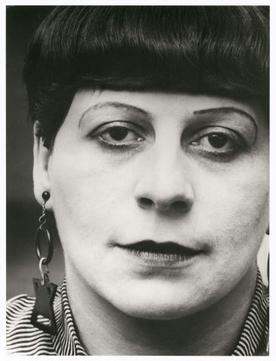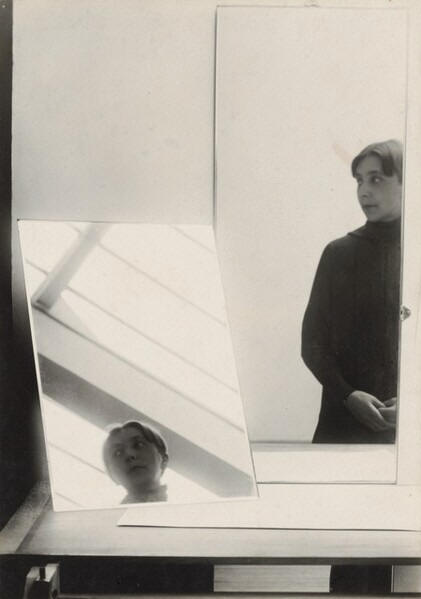

Partner Margarete Schall
Queer Places:
Cimetière du Père Lachaise
Paris, City of Paris, Île-de-France, France
 Florence Henri (28 June 1893, New York City – 24 July 1982,
Laboissière-en-Thelle)[1]
was a surrealist artist; primarily focusing her practice on photography and
painting, in addition to pianist composition.
Florence Henri (28 June 1893, New York City – 24 July 1982,
Laboissière-en-Thelle)[1]
was a surrealist artist; primarily focusing her practice on photography and
painting, in addition to pianist composition.
Although initially trained as a pianist and a painter, Florence Henri earned artistic renown as an avant-garde photographer. She produced a wide range of photographic work throughout the 1920s and 1930s, including still lifes, portraits, nudes, advertising images, and photomontages.
Henri was born on June 28,1893 in New York to a German mother and a French father who served asdirector of a petroleum company; both parents passed away by the time Henri was fifteen.
Financially independent and culturally cosmopolitan, Henri lived in several European capitals--including Rome, London, and Berlin--before finally settling in Paris in the mid-1920s. In 1924 she had a quickmarriage of convenience to a Swiss house servant in order to facilitate her move to France. As both the center of the art world and a haven for queer artists and writers, Paris was an ideal environment for Henri. There she thrived artistically.
Upon moving to the city in 1925, Henri first enrolled in painting courses at André Lhote's Académie Montparnasse, and then at Fernand Léger and Amédée Ozenfant's Académie Moderne. She explored the formalist vocabularies of geometric abstraction and late cubism, tendencies that would eventually inflecther photographic style.

Margarete Schall, 1928
Not on View
Medium
gelatin silver print mounted on paperboard
Dimensions
sheet (trimmed to image): 16.7 x 11.8 cm (6 9/16 x 4 5/8 in.)
support: 18 x 13 cm (7 1/16 x 5 1/8 in.)
Credit Line
Patrons' Permanent Fund
Accession Number
1995.36.88
Artists / Makers
Florence Henri (artist) American, 1893 - 1982
Upon returning to Paris, Henri began taking portraits, self-portraits, and still lifes with inserted mirrors, a strategy that served to disrupt dramatically her compositions and disorient the viewer. The mirror became Henri's favorite prop, and she rarely made still lifes without them.
When the Great Depression of the 1930s put a strain on her income, Henri opened a highly successful photography studio. To supplement her finances, she accepted advertising projects and trained students. She continued to make and exhibit artistic work, experimenting with many of the avant-garde movements and tendencies of the inter-war period, including abstraction, surrealism, and the New Vision. Yet no single artistic program could contain her transgressive imagination, and she refrained from pledging a permanent allegiance to any of them.
Although she never publicly acknowledged her sexual preference, Henri's bisexuality was confirmed after her death in interviews with her friends. It appears her most significant and lasting relationship was with her fellow artist and occasional model, Margarete Schall, with whom she lived in Paris.
Although she always insisted that her images were merely formalist exercises and should not be analyzed for content, Henri had a unique means of addressing gender and sexuality in her photography. Her many self-portraits, for example, demonstrate how she emphasized her female-ness to a virtually theatrical extent.
With her bobbed haircut, dramatic makeup, and fanciful fashion sense, in these portraits Henri can be read as the prototypical neue Frau (new woman)--an individual who embraced modernity to challenge traditional gender roles without nullifying the notion of gender difference. Rather than defy the binary codes of gender via androgyny or cross-dressing (as did her contemporaries Marcel Duchamp and Claude Cahun), Henri preferred to masquerade her given sex, thereby heightening its performative aspects.
Henri's malleable sexual identity manifested itself within her photographs, which demonstrate not only her distinctively modern appearance, but include compositional references to the constructed nature of gender as well. This aspect of her photography is most immediately visible in her best-known image, a 1928 self-portrait in which Henri appears in a long, vertical mirror with two metallic balls at its base. The composition has been given multiple interpretations by various art historians; some see it as unequivocally phallic, while others point to the vaginal nature of the mirror's depth and the breast-like appearance of the metallic balls.
A significant portion of Henri's oeuvre is composed of portraits of young women, many of whom were her students. Her few portraits of men tend to depict her male artist friends, such as Léger, Wassily Kandinsky, and Robert Delaunay. This discrepancy hints at Henri's own attraction to women; while women might be subjects of interest (or desire) in and of themselves, the appeal of men was dependent on their significance as artists.
Henri's sexuality may be even more a factor in the success of her alluring female nudes. These figure compositions are unarguably erotic, and put a twist on art history's many reclining nude female figures in repose. In one such image, the head and chest of a model appear lying on a blanket, the texture and folds of which are meant to be read as a bed of sand. This illusion is reinforced by a few inserted props, including a conch shell and a tuft of grass that peeks out from the lower left corner of the photograph. The evocative shape and placement of the conch shell can easily be interpreted as a vaginal symbol. Moreover, the woman's downward-turned gaze is aimed directly at the shell, a detail that begs for this image to be interpreted as an allegory of lesbian desire.
Henri participated in several key photography exhibitions between the wars, such as the seminal 1929 Filmund Foto show in Stuttgart. She spent the duration of World War II in Paris. After the war, however, she ceased most of her photographic activity and returned her attention to painting, working primarily on landscapes inspired by her European travels. The significance of her painterly work has thus far been overshadowed by the strength of her photography.
Although her renown in the art world gradually faded after she abandoned photography, Henri was rediscovered to some degree in 1974, when Cologne gallery owner Ann Wilde devoted a solo exhibition to her work.
Henri died in a small village outside of Paris in on July 24, 1982.
Though she has yet to achieve the fame of many of her contemporaries, her work continues to garner interest from art historians and critics.
My published books: